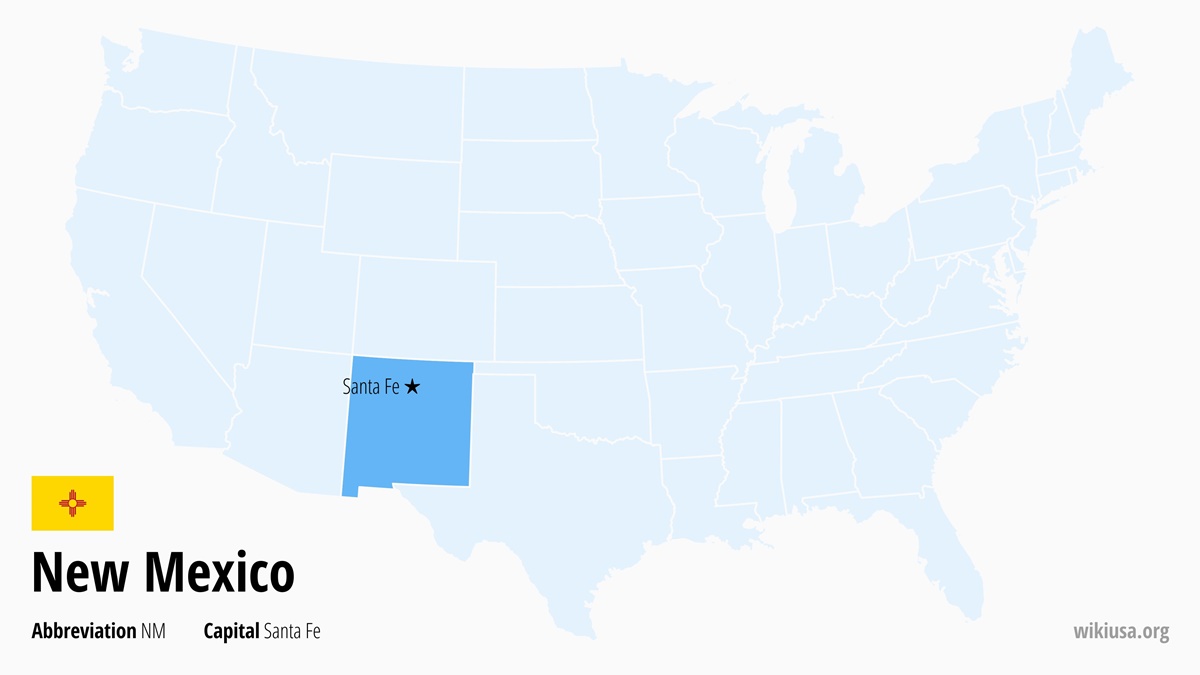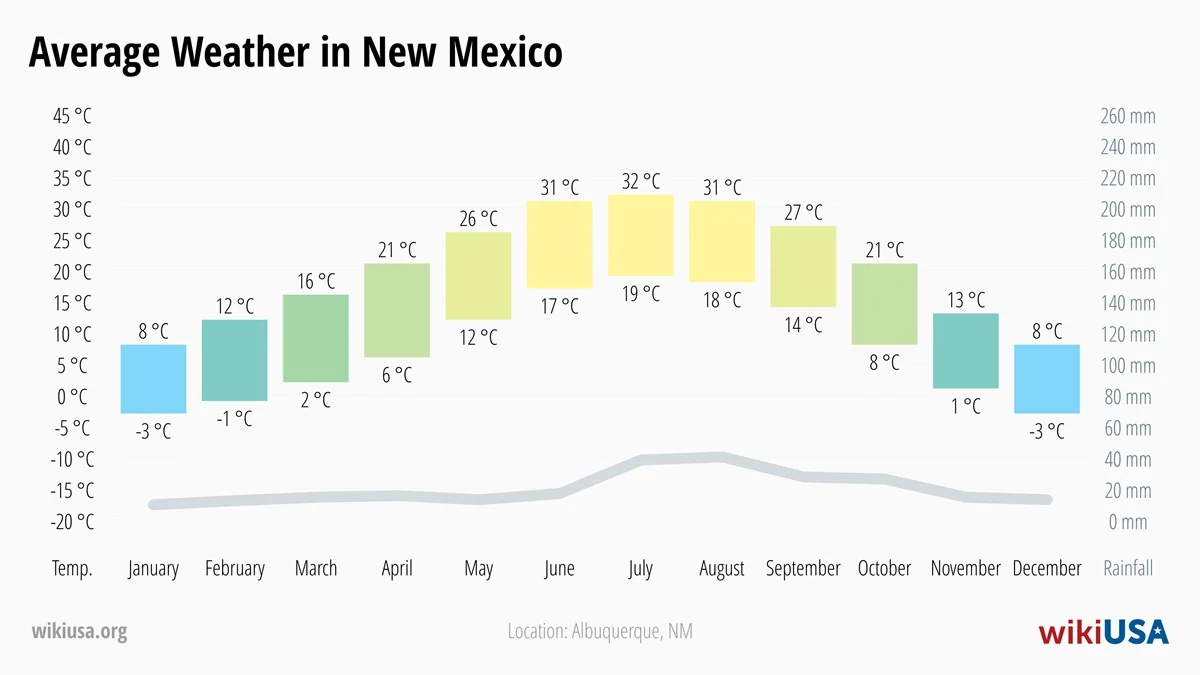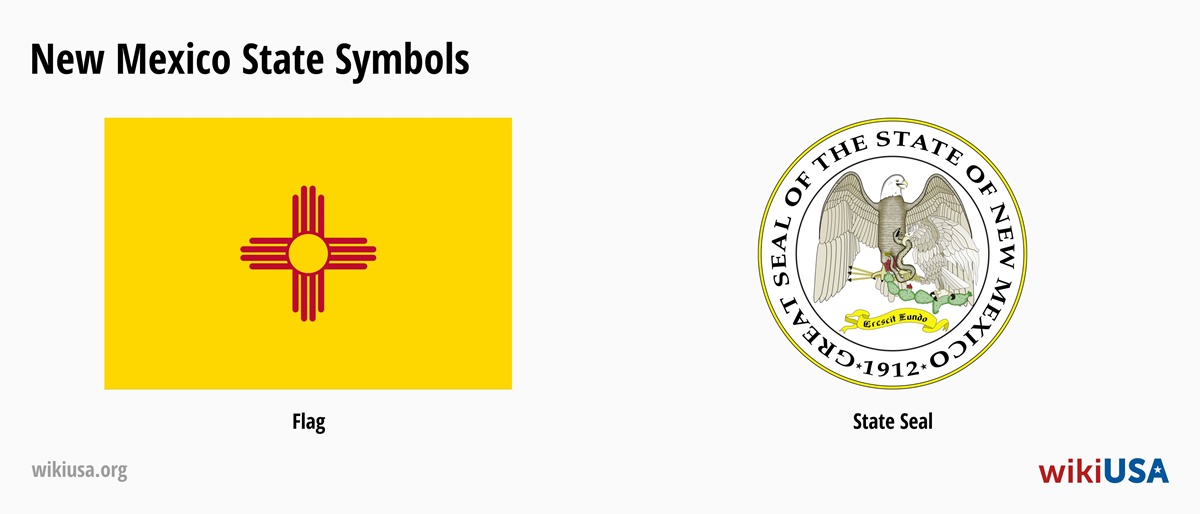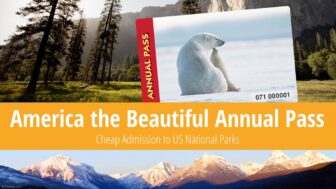New Mexico (NM) is located in the southwestern United States, the state has a rich history influenced by Native Americans and Spanish settlers. Oil and gas production and tourism are important to New Mexico’s economy. The capital of New Mexico is Santa Fe, but most people live in Albuquerque. Major tourist attractions in New Mexico include Carlsbad Caverns and White Sands National Parks.
-
Table of Contents
Quick Facts
Name New Mexico Abbreviation NM Capital Santa Fe Largest city Albuquerque (Population: 560 274) Current time 10:56 Time zone MST (UTC-7), the state observes summer time MDT (UTC-6) Population 2,117,525 (#36 most populous US state) Area 121,589 sqmi (#5 largest US state) Admitted to the Union January 6, 1912 (#47 state to join) ⭐ Capital of New Mexico
The capital of the state of New Mexico is Santa Fe. Founded in 1610 by Pedro de Peralta, governor of the Viceroyalty of New Spain, it immediately became the capital of the province of Nuevo México. Santa Fe became the capital of the state of New Mexico upon its admission to the Union on January 6, 1912.
🏙️ Largest City in New Mexico
The largest city in New Mexico is Albuquerque, with a population of 560,274 in 2023. The second largest city is Las Cruces with a population of 114,892 and the third largest city is Rio Rancho with a population of 110,660.
🕒 Time in New Mexico
The current time in New Mexico is 10:56. Mountain Standard Time (MST, UTC-7) is in effect in the state, with a change to Daylight Saving Time (MDT, UTC-6) between March and November. Some areas of the Navajo Nation may have their own rules for daylight saving time.
🧑🤝🧑 Population of New Mexico
New Mexico had a total population of 2,117,525 according to 2023 data, making the state the 36th most populous in the United States.
📍 Area of New Mexico
New Mexico’s total area is 121,589 sqmi, of which 121,298 sqmi is land and only 292 sqmi is water. New Mexico is the 5th largest state in the USA.
-
Fun Facts About New Mexico
🧩 New Mexico Neighboring States
New Mexico is bordered by four American states. Arizona to the west, Colorado to the north, and Oklahoma and Texas to the east. In addition, it borders Mexico to the south.
📅 Date of New Mexico Statehood
New Mexico was admitted to the Union on January 6, 1912 as the 47th state in the order, its predecessor being the Territory of New Mexico.
📛 Nickname of the State of New Mexico
The state of New Mexico is nicknamed “The Land of Enchantment”, a nickname it boasts on its license plates. The Land of Enchantment refers to the state’s natural beauty, which often has elements of mystery. According to surviving information, the nickname was first used in 1926 in the state’s promotional materials.
⛰️ Highest Mountain in New Mexico
The highest mountain in New Mexico is with 13,167 ft Wheeler Peak, located in the northern part of the state in the Sangre de Cristo Mountains. The mountain was named in honor of cartographer and explorer George Montague Wheeler, who for ten years led expeditions across New Mexico and other states to collect geological, biological, topographical, and other data.
🏞️ Rivers in New Mexico
The longest river in New Mexico is the Rio Grande, with a total flow length of 1,885 mi. It is followed by the Pecos River (926 mi), Canadian River (906 mi), Cimarron River (698 mi) and Gila River (652 mi).
🎓 Universities in New Mexico
The largest university in the state is the University of New Mexico, headquartered in Albuquerque and with a tradition dating back to 1889, it currently has around 31,000 students. New Mexico State University, with its main campus in Las Cruces, is the second largest, with around 19,000 students. The third largest university is the Eastern New Mexico University from the city of Portales, with around 9,000 students.
✉️ New Mexico ZIP Codes
New Mexico has dedicated zip code ranges 870xx-871xx, 873xx-875xx and 877xx-884xx. You can look up the ZIP code for a specific address on the USPS website, and the principle of how it works is explained in the article ZIP Codes in the USA.
-
Weather in New Mexico
The best times to visit New Mexico are late spring and early autumn, when temperatures are pleasant and rainfall is minimal. This is the best time for travel and hiking conditions.
Spring in New Mexico tends to be dry and warm, with temperatures gradually rising from March 43 °F to 54 °F to May 61 °F to 72 °F. Rain showers are rare.
Summers in New Mexico are hot, especially in areas to the south where temperatures often exceed 95 °F. Temperatures in the north of the state and in mountainous areas tend to be a few degrees lower. July and August are periods of short but intense rainfall, which can lead to flash floods.
Autumn in New Mexico brings pleasant weather with temperatures between 54 °F and 64 °F. Rainfall is minimal, making autumn the ideal season for outdoor activities.
Winters in New Mexico are mild, with temperatures typically hovering just above freezing around 32 °F to 41 °F. It is freezing mainly at night or in mountainous areas where snow showers may occur. In most of the area, winters are dry.
🌡️ Average Temperatures and Precipitation in New Mexico
-
Things to Do in New Mexico
1️⃣ Carlsbad Caverns National Park
Carlsbad Caverns National Park is known for its extensive limestone caves, some of which are the largest in the world. To date, 119 caves have been discovered in the park, the most famous of which is the Big Room.
Visitors to the park can either explore the caves on their own or take one of the organized guided tours. The caves are home to 17 different species of bats, with the total number of bats during the summer months estimated at 200,000 to 500,000. Interestingly, the temperature inside the caves remains a constant 55 °F.
2️⃣ Taos Pueblo
Taos Pueblo is one of the oldest continuously inhabited settlements in the world, which has earned it a place on the UNESCO World Heritage List. The indigenous Pueblo community is over 1,000 years old, and their dwellings are traditionally made of adobe bricks, typically ochre in color.
Visitors have the opportunity to get a glimpse of traditional Puebloan life or to take part in dance and religious festivals or other cultural events. Photography is prohibited in some areas.
3️⃣ White Sands National Park
The White Sands National Park is located in the southern part of the state in an area of 227.8 sqmi and is unique in its environment. The park is made up of huge gypsum dunes, which in some places reach heights of up to 30 ft, so sledding and sandboarding are popular activities among children and adults.
There are several hiking trails in the park, which offer a nice view of the photogenic dunes. Especially in the summer months, the park can get very hot, so make sure you have plenty of water.
4️⃣ Cumbres & Toltec Scenic Railroad
The Cumbres & Toltec is a historic railroad that offers those interested a unique train ride experience on one of the most beautiful lines in the United States. Commissioned in 1880, the rail line connects the towns of Chama, New Mexico and Antonito, Colorado.
Steam locomotives and period cars travel through a beautiful landscape with views of mountains, forests and rivers. The entire experience takes about six hours and includes lunch and photo stops.
5️⃣ Bandelier National Monument
The Bandelier National Monument is located west of the town of Santa Fe, offering visitors a glimpse of ancient indigenous dwellings carved into the canyon walls. The Anasazi built the dwellings between 1383 and 1466, which are the years that have been discovered on some of the beams.
There are about 70.0 mi hiking trails in the Bandelier area that lead through the canyons, cave dwellings and their remains. During the summer months, the area is extremely hot, so it is recommended to take the tour either early in the morning or in the evening.
6️⃣ Rio Grande Gorge Bridge
The Rio Grande Gorge Bridge is one of the tallest bridges in the United States, located northwest of the town of Taos. Opened in 1965, the road bridge carries 600.0 ft over the Rio Grande River and offers beautiful views of the canyon of the same name, making it a popular stop for photographers. There are viewing platforms on both sides of the bridge accessible for this purpose.
7️⃣ Roswell
Located in southeastern New Mexico, Roswell became famous due to conspiracy theories that a UFO crash occurred in the town in 1947. The locals dealt with it in their own way, and today Roswell is home to an international UFO museum and research center that is open to the public. Roswell hosts an annual UFO festival that attracts enthusiasts from all over the world.
8️⃣ Petroglyph National Monument
Petroglyph National Monument on the outskirts of Albuquerque protects one of the largest collections of petroglyphs in North America. Native Puebloans and early Spanish settlers carved over 24,000 different images depicting animals, spiritual themes, and various other symbols into the rocks here. There are several hiking trails along the petroglyph rocks, complete with information boards explaining their meaning.
9️⃣ Santa Fe Plaza
Santa Fe Plaza forms the historic heart of New Mexico’s capital city. It is surrounded by museums, galleries, and other buildings characterized by a material known as “adobe”. In Spanish, this word refers to adobe, or unfired clay. The buildings around the square are ochre with rounded edges and usually have only one floor.
Santa Fe Plaza has long been the main commercial and social center of the city, hosting markets, concerts, festivals, and other cultural events.
🔟 Albuquerque International Balloon Fiesta
The Albuquerque Hot Air Balloon Festival is one of the largest in the world. Thousands of visitors and hundreds of hot air balloons take part in the festival every October, with the biggest attraction being the mass launch during sunrise. Those interested can take a ride in a hot air balloon for a bird’s eye view of the event. The hot air balloon festival also includes concerts, competitions and food stalls.
-
Largest Cities in New Mexico
The table below shows the ten largest cities in the state of New Mexico in 2023, the source of the data is the United States Census Bureau, a federal agency whose main task is to count the population.
City County Population 1 Albuquerque Bernalillo 560,274 Map of Albuquerque 2 Las Cruces Doña Ana 114,892 Map of Las Cruces 3 Rio Rancho Sandoval, Bernalillo 110,660 Map of Rio Rancho 4 Santa Fe Santa Fe 89,167 Map of Santa Fe 5 Roswell Chaves 47,109 Map of Roswell 6 Farmington San Juan 46,237 Map of Farmington 7 Hobbs Lea 39,386 Map of Hobbs 8 Clovis Curry 37,612 Map of Clovis 9 Carlsbad Eddy 31,499 Map of Carlsbad 10 Alamogordo Otero 31,284 Map of Alamogordo -
Sports Teams in New Mexico
🏒 Ice Hockey (NHL)
There are no teams from New Mexico in the NHL ice hockey league.
🏈 American football (NFL)
There is no team in New Mexico that plays in the NFL.
🏀 Basketball (NBA)
New Mexico is not represented in the NBA basketball league.
⚾ Baseball (MLB)
There is no team from New Mexico in the MLB league.
⚽ Soccer (MLS)
No team from New Mexico plays in the MLS.
-
New Mexico State Symbols
All of New Mexico’s official symbols have been approved by the State General Assembly and signed into law by the Governor. Only some of the symbols are listed in the text.
State Flag of New Mexico
The flag of New Mexico in its current design has been in use since March 15, 1925, and is one of the simplest of all US states in its graphic design. It consists of the red sacred sun symbol of the Zia tribe on a golden field. The symbol represents the sacred number four, the four directions, the four seasons, the four parts of the day and the four stages of life. The yellow and red colors refer to the history of the state associated with Spain.
In 2001, the North American Vexillological Association declared New Mexico’s flag the most beautiful of all American states.
Great Seal of New Mexico
The Great Seal of State has been used in its current design since 1913, the year after New Mexico became a member of the Union. The seal depicts a large bald eagle protecting a smaller Mexican eagle, symbolizing the protection of the United States over the former Mexican territory. The symbol is accompanied by the official state motto “Crescit eundo”.
State Song
The official state song since March 14, 1917, is O Fair New Mexico, composed and written by local native Elizabeth Garrett.
State Flower
Since March 14, 1927, the state flower of New Mexico has been the yucca, which is abundant in the desert and arid regions of the state. The plant is characterized by its long sword-shaped leaves and white flowers. Around 40 species of yucca grow in the state, the most widespread being yucca elata.
State Tree
In 1949, the Colorado pinyon (Pinus edulis), which occurs naturally throughout the southwestern United States, was designated the state tree. The pine tree is distinctive for its edible seeds, which are known as pine nuts. Their harvesting is a traditional activity in New Mexico in the fall.
State Amphibian
The New Mexico spadefoot toad (Spea multiplicata), a toad with a size of up to 6 cm usually lives at night, joined the list of state symbols in 2003.
State Animal
The official state animal of New Mexico since 1963 is the black bear (Ursus americanus), which is found in the forested and mountainous areas of the state. The black bear symbolizes the strength and wild beauty of the state, and is also featured as Smokey Bear in forest fire prevention campaigns. Interestingly, the campaign is based on a real bear cub that was rescued in a New Mexico wildfire.
State Bird
The state bird was designated in 1949 as the greater roadrunner (Geococcyx californianus), which is abundant in the desert and semi-desert regions of New Mexico. The bird is a good runner, and can often be seen crossing roads and open spaces at high speeds. The roadrunner can run at speeds up to 20 mph, and is also known as a character in the Looney Tunes animated series, where it escapes from a coyote.
State Question
In 1999, New Mexico enacted its official state question, which is “Red or Green?” This is a very common question in local restaurants, where servers ask diners if they want their food prepared with red or green chili peppers.
State Scent
New Mexico passed a unique law in 2023 that defines the official state scent. The symbol became the smell of roasted green chili peppers, which are a traditional part of the local cuisine.

 10 Best Photo Places in the USA
10 Best Photo Places in the USA







Contribute with Your Question or Personal Experience